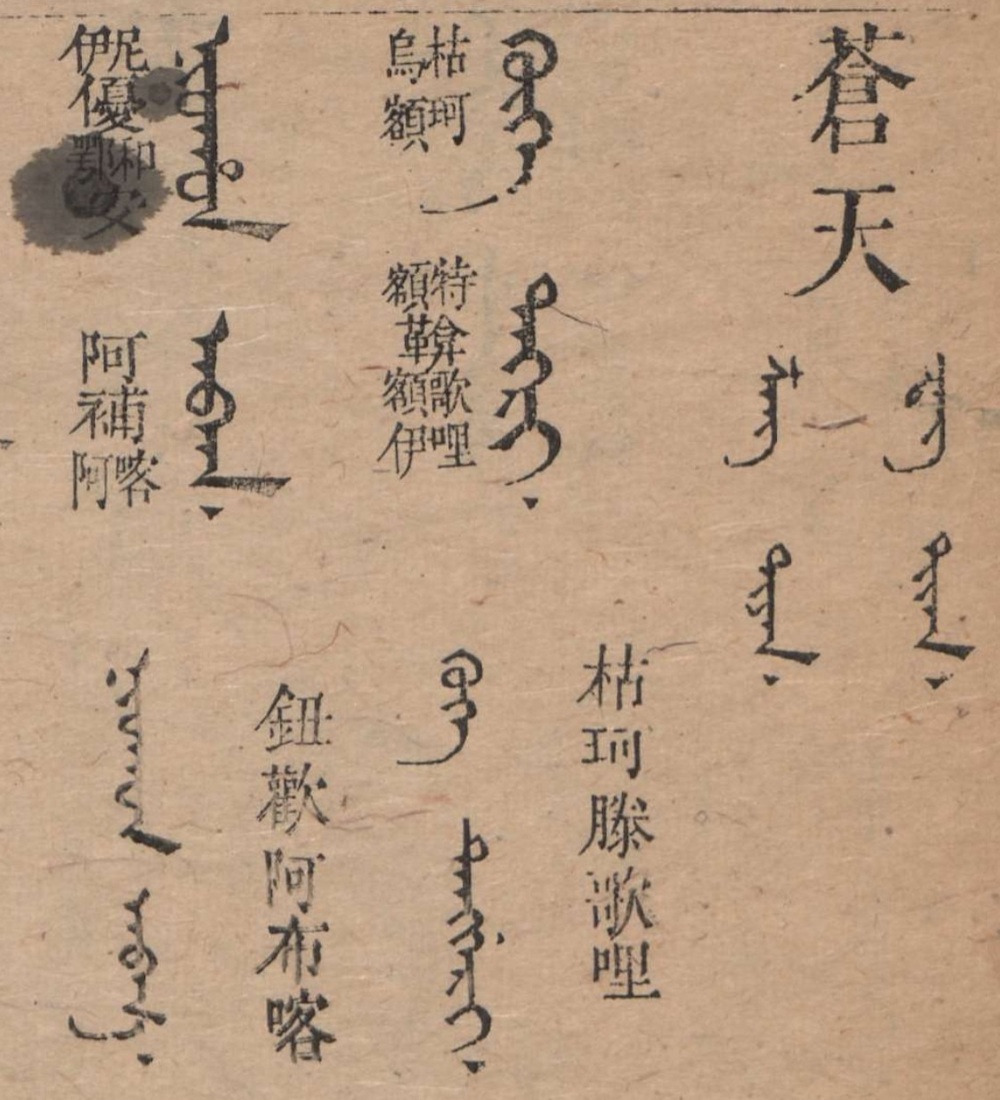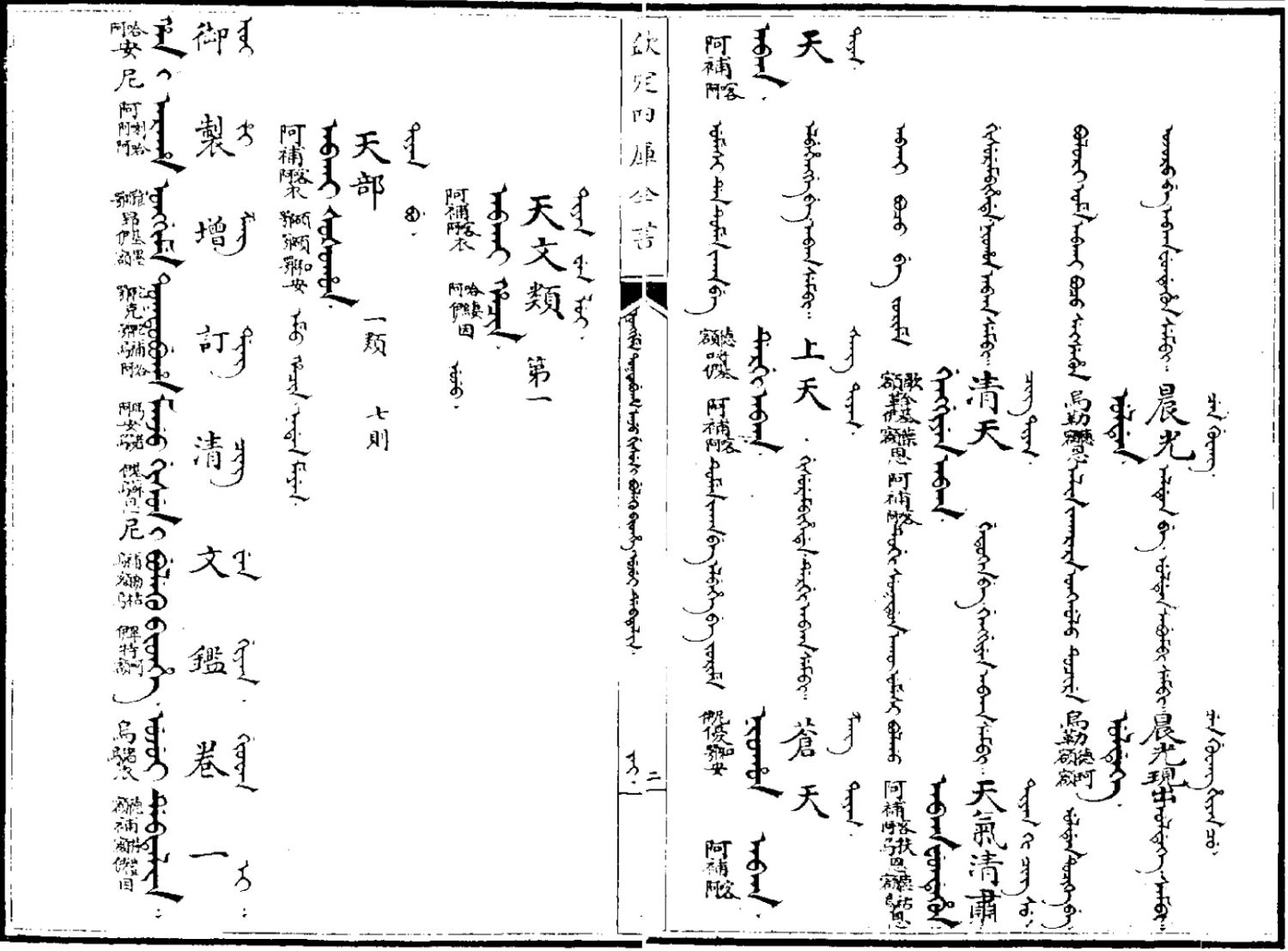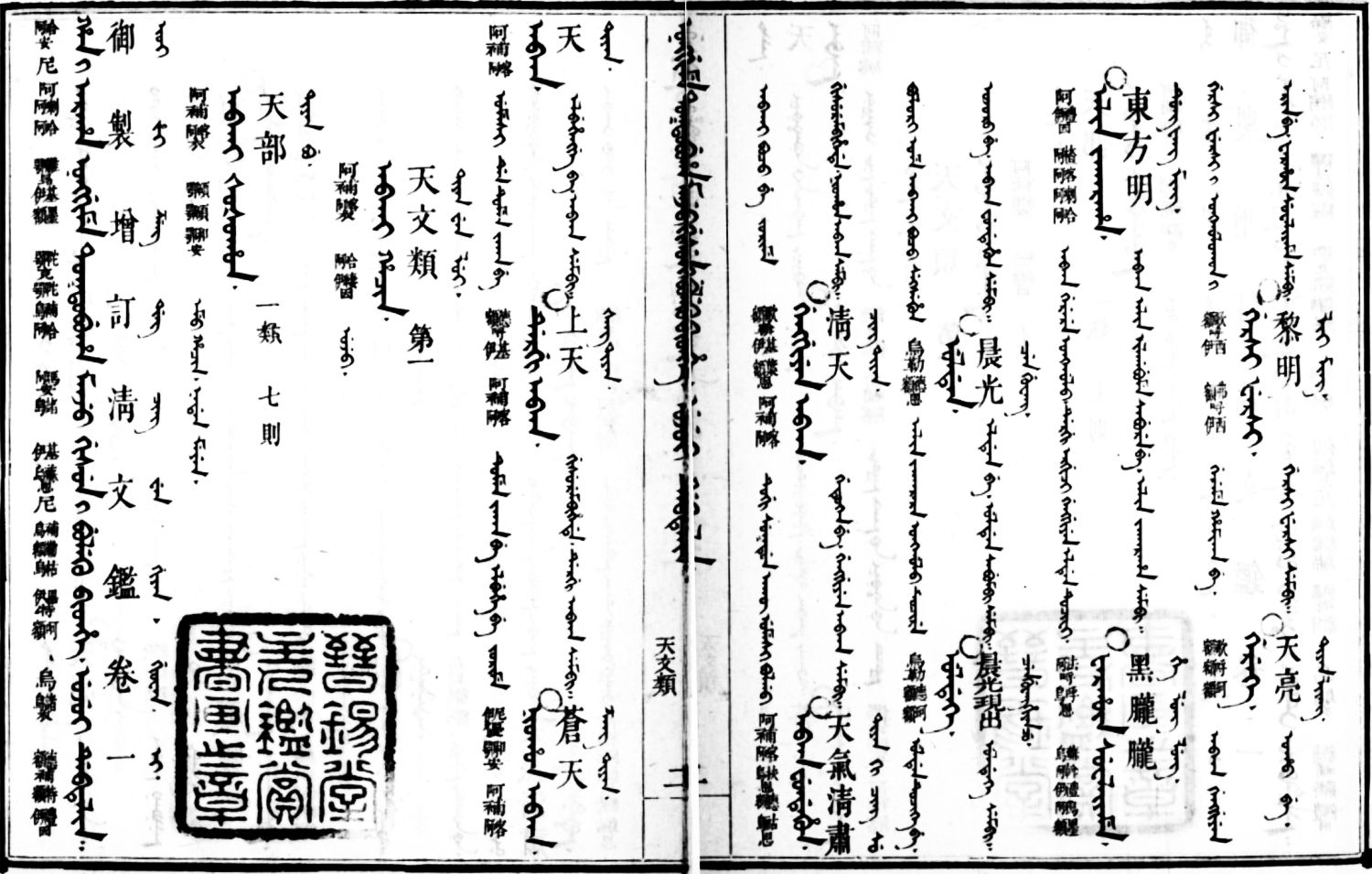Qingwenjian 清文鑒 "Mirror to the national language", officially called Yuzhi qingwen jian 御制清文鑒, is a series of multi-lingual dictionaries from the Qing period 清 (1644-1911) compiled on imperial order. "National language" (literally: "the language of the Qing") means Manchurian.
The oldest version, the Qingwen jian, was compiled during the years 1673 to 1708. During the Qianlong reign-period 乾隆 (1736-1795), some extensions to it were written, the Man-Meng wen jian 滿蒙文鑒 (Manchu-Mongol dictionary), Liangti qingwen jian 兩體清文鑒 (idem), Santi qingwen jian 三體清文鑒 (including Manchurian, Mongolian, and Tibetan), the Zengding qingwen jian 增訂清文鑒 (finished in 1771), Manzhu-Menggu-Hanzi sanhe qieyin qingwen jian 滿珠蒙古漢字三合切音清文鑒, Siti qingwen jian 四體清文鑒 (Manchurian, Mongolian, Chinese, and Tibetan), and the most famous of the series, the Wuti qingwen jian 五體清文鑒 (Manchurian title Han-i araha sunja hacin-i hergen kamciha manju gisun-i buleku bithe "Mirror of the Manchu language with an overview of five different languages, compiled by the Emperor").
 |
Edition of the Three-Languages Mirror from 1771, titled Han i araha manju monggo nikan hergen ilan hacin i mudan acaha buleku bithe (Yuzhi Manzhou-Menggu-Hanzi sange qieyun Qingwen jian 御製滿洲蒙古漢字三合切韻淸文鑑, first chapter. The chapter begins (left to right) with the Manchu word niohon abka "Blue sky/Heaven", transcribed into Chinese in a meticulous way according to the fanqie 反切 method as 尼伊優和鄂安 (/n-i you h-e an/ = niohan) 阿補喀阿 (/a bu k-a/ = abka), and is repeated with the direct transcription niuhuan abuka 鈕歡阿布喀. In the next column (middle in the image), the Mongolian expression köke tngri is presented in Mongolian script, transcribed into Chinese with the fanqie method as 枯烏-珂額 (/k-u k-e/ = köke) 特額-鞥-歌額-哩伊 (/t-e eng g-e l-i/ = tngri), repeated below in a direct way as kuke tenggeli 枯珂滕歌哩. Finally (right), the Chinese word and characters are presented, cangtian 蒼天, transcribed into Mongolian (chng tiyan) and Manchu (tsang tiyan. Copy owned by the Staatsbibliothek Berlin. |
The Qingwenjian is 46-juan long, with a supplement of 4 juan, a general introduction (zonggang 總綱) of 8 juan and a supplement to the latter (bu zonggang 補總綱), in 2 juan. It was an attempt to compile a handbook for old Manchurian, which was written in a different way than after the script reform of 1632 (wu juandian Manwen 無圈點滿文 "Manchurian without diacritic dots", tongki fuka akū hergen, in contrast to you juandian Manwen 有圈點滿文, tongki fuka hergen).
 |
First chapter, lemmata on "Heaven" (abka / tian 天). Edition with both Chinese, and Manchu titles in the fold. Copy from Chizaotang Siku quanshu huiyao 摛藻堂四庫全書薈要. |
 |
Edition with the Manchu title of the book in the fold. The seal says, 晉錫堂主人鑑賞書畫之章. Copy owned by the Bibliothèque nationale de France. |
This book, finished in 1708, included 280 different themes with more than 12,000 words and terms. The lemmata were arranged alphabetically. The Qianlong emperor first ordered to add phonetic comments to this version, and the dictionary was revised to an enlarged version, the Zengding qingwen jian, with 35 chapters and 292 themes. Each lemma was written in the modern Manchurian script, and translated into Chinese. The Manchurian text was transcribed phonetically into Chinese, and the Chinese explanation of the word was transcribed phonetically into Manchurian. The Qingwenjian and the Sanhe qieyin qingwen jian are included as manuscripts in the imperial series Siku quanshu 四庫全書, the first also in the series Chizaotang Siku quanshu huiyao 摛藻堂四庫全書荟要.
The Wuti qingwen jian was an extension of the Zengding and the Siti versions and is a five-language dictionary, representing words in Manchurian, Tibetan, Mongolian, Chinese, as well as Turki (Uyghurian). The content was also considerably enlarged. The Wuti qingwen jian is 32-juan long and arranged the vocabulary in 36 encyclopaedic fields of meaning, with 292 categories and 556 sub-categories, and a total vocabulary of 17,052 words. There is a supplement of 4 juan length, with 26 more categories and 1,619 additional words, making a total of 36 categories and 18,671 lemmata.
For each word, 8 entries are provided: first the Manchurian word, then its Tibetan counterpart, enriched by a literal transcription (qieyin 切音) and a phonetic transcription (duiyin 對音) into Manchurian, then the Mongolian counterpart and the Turki counterpart, supplemented with a phonetic transcription into Manchurian, and finally, the Chinese counterpart of the word or term.
The Wuti qingwen jian has, of course, its value as a dictionary, expecially for the multi-language administrative terminology of the Qing period, but also in respect to linguistic studies of the five languages, especially Tibetan, a language whose modern pronunciation differs extremely from the archaic written form, and also for Turki and its dialects.
The Wuti qingwen jian was finished around the year 1790, but the exact date of compilation is not known because there is no preface. It was brought into book form not before 1805. In 1957, the Minzu Press 民族出版社 published a facsimile of a manuscript version of the palace library, in three volumes. In 1966, the Japanese scholar Tamura Jitsuzō 田村実造 (1904-1999) from the Tōkyō University published a version with a transcription into Latin letters, with the title of Gotai shinbunkan yakukai 五體清文鑒訳解, in two volumes. Another specimen of the original is stored in the British Museum.
In 2013 Oliver Corff published an annotated latinized version (albeit in German) of the dictionary, Auf kaiserlichen Befehl erstelltes Wörterbuch des Manjurischen in fünf Sprachen ("Fünfsprachenspiegel"): Systematisch angeordneter Wortschatz auf Manjurisch, Tibetisch, Mongolisch, Turki und Chinesisch, Wiesbaden: Harrassowitz.
| no. | Man. | Mong. | Chin. | |
|---|---|---|---|---|
| 1. | Abka | Tngri | 天 | Heaven |
| 2. | Erin jurgan | Čaɣ ularil | 時令 | Seasons and time |
| 3. | Na | Γaǰar | 地 | The earth |
| 4. | Han | Qaɣan | 君 | Rulers |
| 5. | Hese | J̌arliɣ | 諭旨 | Edicts |
| 6. | Hafan sindara | Tüsimel talbiqu | 設官 | Offices |
| 7. | Dasan | J̌asaɣ | 政 | Reigning |
| 8. | Dorolon | Yosulal | 禮 | Rites |
| 9. | Kumun | Kögǰim | 樂 | Ritual music |
| 10. | Šu tacin | Udq-a surulɣ-a | 文學 | Literature |
| 11. | Cooha-i gungge | Čirig-ün güng | 武功 | War |
| 12. | Niyalma | Kömün | 人 | Man |
| 13. | Hūwašan doose | Quušang bumbu | 僧道 | Buddhism and Daoism |
| 14. | Ferguwecuke aldungga | Γ'ayiqamsiɣtu ǰigtei | 奇異 | Strange things |
| 15. | Oktosi saman | Emči böge | 醫巫 | Medicine and magic |
| 16. | Faksi muten | Uran čidal | 技藝 | Arts and skills |
| 17. | Dere tomoro | Saɣuqu orusiqu | 居處 | Houses and buildings |
| 18. | Boigon hethe | Erüke körüngge | 產業 | Products |
| 19. | Tuwa šanggiyan | Γal utaɣan | 火 | Fire |
| 20. | Suje boso | Torɣa bös | 布帛 | Textiles |
| 21. | Etuku miyamigan | Qubčasu čimeg | 衣飾 | Clothing and adornment |
| 22. | Tetun jaka | Saba yaɣuman | 器皿 | Tools |
| 23. | Fejilere arara | Üiledkü kikü | 營造 | Construction |
| 24. | Jahūdai | Ongɣučan | 船 | Ships and boats |
| 25. | Sejen kiyoo | Terge seüke | 車轎 | Carts and chariots |
| 26. | Jedere jaka | Idekü yaɣuman | 食物 | Eating |
| 27. | Hacingge jeku | J̌üil büri tariyan | 雜糧 | Miscellaneous agrarian products |
| 28. | Hacingge tubihe | J̌üil büri ǰimis | 雜果 | Miscellaneous fruits |
| 29. | Orho | Ebesün | 草 | Grasses and herbs |
| 30. | Moo | Modun | 樹木 | Trees |
| 31. | Ilha | Čečeg | 花 | Flowers |
| 32. | Gasha cecike | Sibaɣu bilǰuuqayi | 鳥雀 | Birds |
| 33. | Gurgu | Görugesun | 獸 | Beasts |
| 34. | Ulha ujima | Mal teǰigebüri | 牲畜 | Cattle |
| 35. | Esihengge hurungge | Qayirsutu qabtasutu | 鱗甲 | Fishes and scaly animals |
| 36. | Umiyaha | Qoruqai | 蟲 | Insects and worms |